Our PDF dumps of 70-246 exam is designed to ensure everything which you need to pass your exam successfully. At GreatExam, we have a completely customer oriented policy. We invite the professionals who have rich experience and expert knowledge of the IT certification industry to guarantee the PDF details precisely and logically. Our customers’ time is a precious concern for us. This requires us to provide you the products that can be utilized most efficiently.
QUESTION 51
Hotspot Questions
Your company help desk uses System Center 2012 Service Manager to manage and track problems.
You need to ensure that the manager of the help desk is notified automatically when a high-priority incident is updated.
What should you configure? To answer, select the appropriate configuration in the answer area.

Answer: 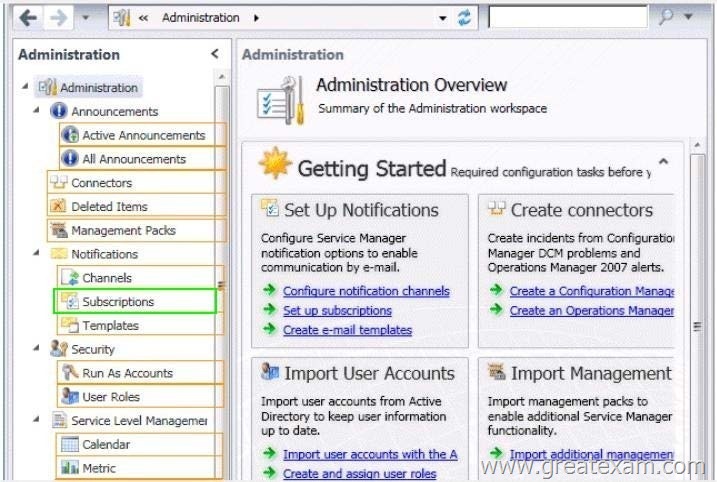
Explanation:
http://technet.microsoft.com/en-us/library/ff460891.aspx
Before notifications are sent, first configure each notification channel, such as the settings for Simple Mail Transfer Protocol (SMTP).
Notification messages are sent based on a notification template.
Therefore, you will need to create a notification template.
You can then use the Notification Subscription wizard to subscribe a group of users to a notification that will be sent whenever the changes that you specify occur.
Finally, you can verify that a notification is sent by manually generating the change.
QUESTION 52
Your role of Systems Administrator at ABC.com includes the management of the company’s private cloud.
The private cloud is hosted on an internal System Center 2012 infrastructure.
System Center 2012 – Operations Manager (SCOM) is used to monitor all network devices.
The network has a leased line connection to your ISP.
A router managed by the ISP connects the leased line to the LAN.
The router is configured to allow only the ISP to access the configuration of the router to comply with the security policy of the ISP.
You want to use System Center 2012 – Operations Manager (SCOM) to monitor the router and alert you if the router goes offline.
You need to configure SCOM to discover the router while adhering to the ISP security policy.
Which access mode should you use?
A. SNMPv2 only.
B. ICMP only.
C. ICMP and SNMPv2.
D. SNMPv2 and SNMPv3.
Answer: B
Explanation:
This is a tricky question, but the answer is B, ICMP (ping) only. The question says “Operations Manager (SCOM) is used to monitor all network devices.”… This made me think that the answer had to be both ICMP & SNMPv2 (C), but that is wrong! It is wrong because if we specify that a device uses both ICMP and SNMP, Operations Manager must be able to contact the device by using both methods or discovery will fail. So it has to be B.
Also worth noting that in Operations Manager, only ONE network discovery rule can be running per Management/Gateway server. Each server can only run one network discovery.
Here’s a good post regarding network discovery in SCOM. http://blogs.technet.com/b/ptsblog/archive/2011/11/28/network-monitoring-with-system-center-operationsmanager-2012.aspx
QUESTION 53
Hotspot Question
You have a System Center 2012 R2 infrastructure that contains three servers.
The servers are configured as shown in the following table.
You need to create a self-service request offering that will allow users to provision new virtual machines.
On which server should you perform each of the following actions?
To answer, select the appropriate server for each action in the answer area.
Answer: 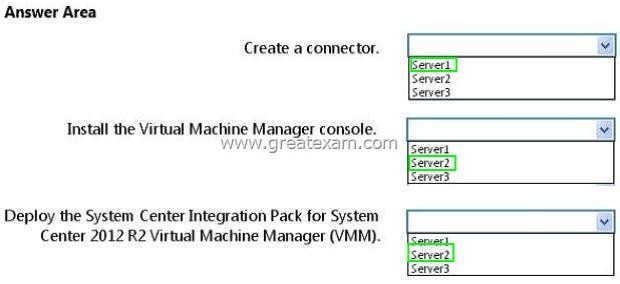
QUESTION 54
Your company has a private cloud that is managed by using a System Center 2012 Operations Manager infra structure.
You have a line-of-business web application named App1.
App1 stores its information in a dedicated Microsoft SQL Server 2008 database.
You need to create a central diagram that contains the complete health information of Appl.
You import the SQL, IIS, and Windows Server management packs.
What should you create next?
A. a dashboard view
B. a distributed application model
C. a Service Level Dashboard
D. a diagram view
Answer: B
Explanation:
You need to create a distributed application first to be able to create the service level dashboard.
First a DA, followed by a service level objective, and finally a Service Level Dashboard.
http://technet.microsoft.com/en-us/library/hh212692.aspx
http://technet.microsoft.com/en-us/library/hh230719.aspx
QUESTION 55
Drag and Drop Questions
Your company has a private cloud that is managed by using a System Center 2012 Operations Manager infrastructure.
You need to ensure that members of a group named Group1 can resolve printing alerts by using the Operations Manager console.
The solution must minimize the number of Operations Manager permissions assigned to Group1.
Which three actions should you perform in sequence? (To answer, move the appropriate actions from the list of actions to the answer area and arrange them in the correct order.)
Answer: 
Explanation:
1. Import the Windows Server Print Server Management Pack – Required for monitoring printing
http://technet.microsoft.com/en-us/library/cc181012.aspx
2. Create an Operator User Role – Required to add Group1 to SCOM
3. Scope the User Role – To set this role to access print alerts only
No – Create an event viewer alert, technically feasible to set logging of print queues and then monitor events but Microsoft always asked for the BEST solution, hence the Print MP
No – Create a Subscription, there is no mention of notifications in the question
No – Create a run as account, the question says resolve the print ALERT not the fault itself
QUESTION 56
Your company has a datacenter in Los Angeles that contains a System Center 2012 Operations Manager infrastructure.
You create three unsealed management packs named Pack1, Pack2, and Pack3.
You create an override for Pack1.
You create a group in Pack2.
You need to apply the override for Pack1 to the group in Pack2.
What should you do before you apply the override?
A. Seal Pack1.
B. Create a new class in Pack3.
C. Create a new class in Pack1.
D. Seal Pack2.
E. Create a new class in Pack2.
Answer: D
Explanation:
When you create a group, you save it to an unsealed management pack. However, an element in an unsealed management pack, such as a group, cannot reference an element in a different unsealed management pack, such as an override or a view. If you are going to use a group to target an override or scope a view, you must either save the group to the same unsealed management pack as the override or view, or you must seal the management pack that contains the group. If you save the group to the same unsealed management pack as the override or view, you can only use that group for overrides and views that are also contained in that unsealed management pack. If you seal the management pack that contains the group, you can reference that group from other unsealed management packs. However, you cannot easily change any group settings in the sealed management pack or add new groups to the sealed management pack.
http://www.code4ward.net/main/Blog/tabid/70/EntryId/130/Implications-when-using-groups-from-a-sealed-MPfor-overrides.aspx
QUESTION 57
Hotspot Questions
Your company has a private cloud that contains a System Center 2012 Service Manager infrastructure.
The help desk uses Service Manager to manage and track incidents.
Service desk analysts report that they receive many Windows 7-related incidents.
You need to create a classification for the Windows 7-related incidents.
What should you configure to create the classification? To answer, select the appropriate configuration in the answer area.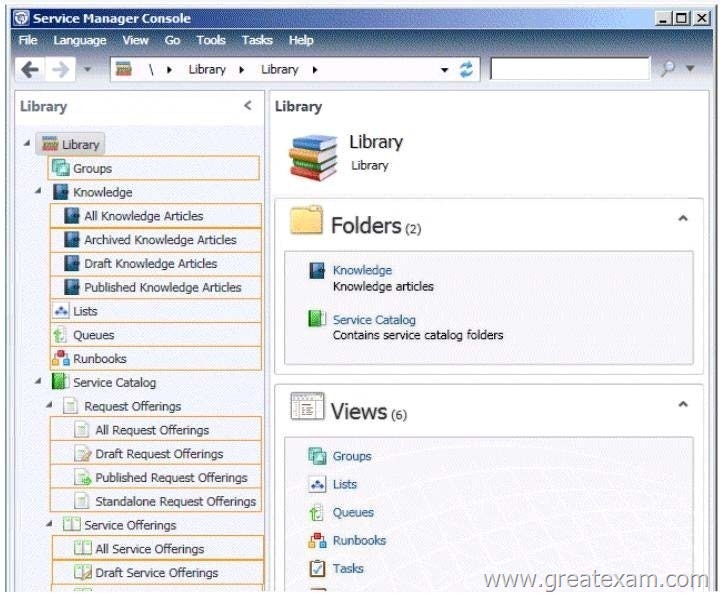
Answer: 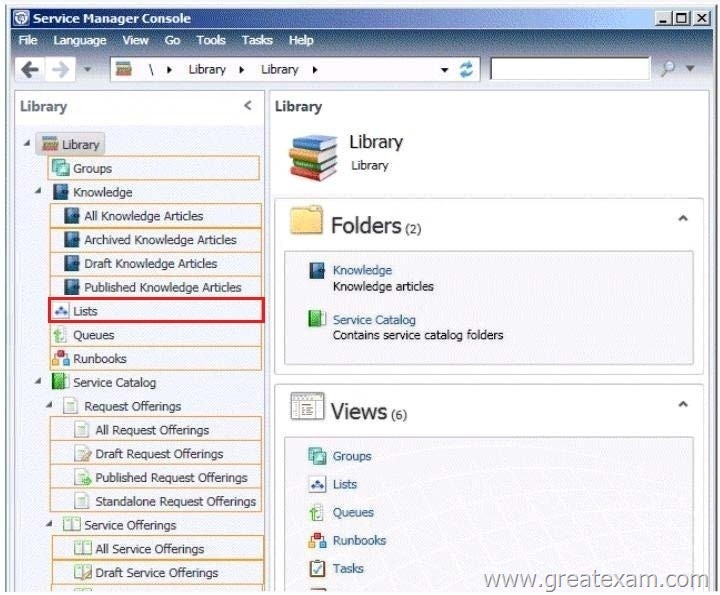
Explanation:
https://www.youtube.com/watch?v=QRWRKL6zA5k
http://social.technet.microsoft.com/Forums/systemcenter/en-US/3c092cb3-734e-4fa3-ba7a-5b5fc9966651/scsm-2012-sorting-of-incident-classification
QUESTION 58
Your company has a private cloud that is managed by using a System Center 2012 infrastructure. You discover that several users create incidents for the same issue by using the Self-Service Portal.
Over 100 incidents are created.
You need to ensure that all of the incidents can be resolved as quickly as possible.
What should you do?
A. create a service level objective (SLO).
B. Create a queue.
C. Select the Link to New Parent Incident task.
D. Select the Escalate or Transfer the Incidents task.
Answer: C
Explanation:
http://wwwco1vip.microsoft.com/downloads/en/details.aspx?FamilyID=01f0792d-f246-4549-a200-53001865495b
How to Create a Parent Incident from an Incident Form
In SystemCenter2012-ServiceManager, one way a help desk analyst can create a parent incident is when an existing incident is already opened. You can create a parent incident using the following steps. A parent incident serves as a container for several incidents. The following procedure is performed on an incident that is neither a parent incident nor a child incident.
Afterward, a new parent incident is created and the existing incident is converted to a child incident.
To create a parent incident from an incident form
1. In the Service Manager console, open the Work Items workspace, and in the Work Items pane, expand Incidents.
2. Select any Incident Management view that contains active incidents, and then select an incident.
3. In the Tasks pane, click Edit to open the incident.
4. In the Tasks pane, click Link to New Parent Incident to open the Link to New Parent Incident dialog box.
5. In the Link to New Parent Incident dialog box, select a template to create the new parent incident with, and then click OK.
For example, select Networking Issue Incident Template, and then click OK.
6. In the Title box, type a new description or modify the description that is inserted by the template.
For example, type Network Outage in Bldg 773.
7. In the Affected user box, select the user who reported this incident. For example, select Joe Andreshak.
8. In the Alternate Contact Method box, enter additional contact information for the affected user (optional).
9. The Child Incidents tab appears in the form where you view the child incident that the new parent incident is grouped with and where you can add other child incidents.
10. In the parent incident form, click OK to close it.
11. In the original incident form, click OK to close it.
QUESTION 59
Your company has a private cloud that is managed by using a System Center 2012 infrastructure. The network contains an Operations Manager infrastructure and a Virtual Machine Manager (VMM) infrastructure.
You implement a Microsoft SharePoint Server 2010 farm that is hosted on 10 virtual machines. The company defines a service level agreement (SLA) for the farm’s availability of at least 99.9 percent uptime.
You need to ensure that the company’s compliance officer can identify whether the SLA requirement is met.
What should you do?
A. Create a distributed application that contains the servers and the services used by the farm.
Create a Service Level Tracking object for the distributed application.
Add a service level objective (SIO), and then set the goal to 99.9 percent.
B. Create a group, and then add all of the farm servers to the group.
Create a Service Level Tracking object.
Add a service level objective (SLO), and then set the goal to 99.9 percent.
C. Create a group, and then add all of the farm servers to the group.
Create a performance collection rule for each front-end Web server m the farm.
Configure an alert if network availability falls below 99.9 percent.
D. Create a distributed application that contains the servers and the services used by the farm.
Create a performance collection rule for each front-end Web server in the farm.
Configure an alert if network availability falls below 99.9 percent.
Answer: A
Explanation:
Adding only the servers doesn’t mean, that the services (SharePoint) are available.
So it must be a distributed application.
http://technet.microsoft.com/en-us/library/hh230719
http://technet.microsoft.com/en-us/library/hh457612.aspx
QUESTION 60
Your company has a private cloud that is managed by using a System Center 2012 Orchestrator, System Center 2012 Operations Manager, and System Center 2012 Service Manager infrastructure.
You discover that a service on a server repeatedly stops.
You need to configure a solution to remediate the recurring issue automatically.
What should you do?
A. From Service Manager, create an incident template.
B. From Service Manager, configure an incident event workflow.
C. From Operations Manager, configure the CI connector.
D. From Operations Manager, create a monitor.
Answer: D
Explanation:
When creating a monitor, you can create a recovery action
From the Unleashed book.
QUESTION 61
Your company has a private cloud that is managed by using a System Center 2012 Operations Manager infrastructure.
You have a distributed application named App1.
App1 has the following service level objectives (SLOs):
– At least 99.9 percent uptime
– No more than 85 percent average CPU utilization
You need to add the SLOs that monitor the required information to Service Level Tracking.
Which SLO or SLOs should you add? (Each correct answer presents part of the solution. Choose all that apply.)
A. Monitor state SLO – Availability
B. Monitor state SLO – Security
C. Collection rule SLO
D. Monitor state SLO – Performance
E. Monitor state SLO – Configuration
Answer: AC
Explanation:
http://technet.microsoft.com/en-us/library/hh230719.aspx
To define a service level objective for an application Open the Operations console with an account that is a member of the Operations Manager Administrators user role.
Click Authoring.
In the navigation pane, expand Management Pack Objects, and then click Service Level Tracking.
In the Tasks pane, click Create.
In the Service Level Tracking dialog box, type a name for the service level that you are defining. For example, type LOB Application 1. Optionally, you can provide a description.
Click Next.
On the Objects to Track page, under Targeted class, click Select. In the Select a Target Class dialog box, select a class for the service level, such as Distributed Application, from the list in the text box.
You can search for a class by typing its name into the Look For text box.
Click OK to close the Select a Target dialog box.
You can use the Scope option to specify the scope for the service level.
The default selection is to use all objects of the targeted class.
Select the management pack that this service level will be saved in.
You can use an existing management pack or create a new one.
Click Next.
On the Service Level Objectives page, click Add, and then click Monitor state SLO to create a new monitor.
This monitor will track the availability of the application.
Define the state monitor as follows:
In the Service level objective name text box, type a name for the service level objective.
For this scenario, type Availability.
From the Monitor drop-down list, choose the specific monitor that you want to use to measure the objective.
For this scenario, choose Availability.
Using the Service level objective goal (%) spin box, provide the numerical measure for your objective. For example, select 99.990 to indicate that your goal is 99.99% availability.
You can refine what the monitor tracks to determine availability by selecting or clearing any of the following state criteria:
– Unplanned maintenance
– Unmonitored
– Monitoring unavailable
– Monitor disabled
– Planned maintenance
– Warning
Click OK.
On the Service Level Objectives page, click Add, and then click Collection rule SLO to create a new collection rule.
This rule will track the performance of the application Define the performance collection rule as follows:
In the Service level objective name: text box, type a name for the service level objective.
For this scenario, type Performance.
Under Targeted class, click Select to open the Select a Target Class dialog box. Specify the target class for the rule from the list of targets in the text box. Note that this class must be contained in the distributed application.
For this scenario, select the specific class the rule is targeted to, such as Windows Server 2008 Operating System.
Under Performance collection rule, click Select to open the Select a Rule dialog box. Specify the performance collection rule to use.
For this scenario, choose Collect Processor\ % Processor Time performance counter, and then click OK.
Using one of the Aggregation method options, choose one of the following:
– Average
– Min
– Max
Use the Service level objective goal drop-down list to specify either Less than or More than, and enter a value in the adjacent text box.
For this scenario, choose Less Than and 80.
This indicates that the performance goal is to never exceed 80% processor time.
Click OK.
On the Service Level Objectives page, click Next.
On the Summary page, review the settings, and then click Finish.
When the Completion page appears, click Close.
QUESTION 62
Your company has a private cloud that is managed by using a System Center 2012 infrastructure. The network contains a Microsoft SharePoint Server 2010 server farm.
The server farm is hosted on 20 virtual machines.
You deploy a custom solution to the SharePoint server farm.
The solution requires that a new Web.config file be deployed to all of the front-end servers.
You need to identify which front-end servers have an outdated version of the Web.config file. What should you do?
A. From Operations Manager, create a monitor.
B. From Service Manager, create a Virtual Machine Manager (VMM) connector.
C. From Virtual Machine Manager (VMM), deploy a service template.
D. From Configuration Manager, deploy a Desired Configuration Management baseline.
Answer: D
Explanation:
Desired configuration management in Configuration Manager 2007 allows you to assess the compliance of computers with regard to a number of configurations, such as whether the correct Microsoft Windows operating system versions are installed and configured appropriately, whether all required applications are installed and configured correctly, whether optional applications are configured appropriately, and whether prohibited applications are installed.
Additionally, you can check for compliance with software updates and security settings.
http://technet.microsoft.com/en-us/library/bb680553.aspx
By Gol: Typical Microsft question.
Should you create a baseline first or just monitor.
For me identify = Operations Manager
QUESTION 63
Your company has a private cloud that is managed by using a System Center 2012 Virtual Machine Manager (VMM) infrastructure.
The infrastructure contains several Hyper-V hosts.
You configure VMM to use an update server and to synchronize the updates by using a Windows Server Update Services (WSUS) server.
You attempt to verify compliance with the Sample Baseline for Security Updates.
You view the console as shown in the exhibit. (Click the Exhibit button.)
You need to ensure that you can verify compliance for the Hyper-v hosts.
What should you modify?
A. the update classifications of the update server
B. the Assignment Scope of the baseline
C. the default configuration provider
D. the Network settings of the All Hosts host group
Answer: B
Explanation:
To add a Windows Server Update Server to VMM
In the VMM console, open the Fabric workspace.
On the Home tab, in the Add group, click Add Resources, and then click Update Server.
The Add Windows Server Update Services Server dialog box opens.
In Computer name, enter the fully qualified domain name (FQDN) of the WSUS server (for example, VMMServer01.contoso.com).
Specify which TCP/IP port that the WSUS website listens on for connections (for example, port 8530).
Enter credentials for connecting to the WSUS server.
The account must have administrator rights on the WSUS server.
If necessary, select the Use Secure Socket Layer (SSL) to communicate with the WSUS server and clients check box.
Click Add.
The WSUS server will be added to VMM, followed by initial synchronization of the updates catalog. Depending on how many update classifications and products you chose when you installed the WSUS server, this operation can take a long time, depending on such factors as network traffic and the load on the WSUS server.
To find out the status of the operation, monitor the status of the Add Update Server and Synchronize Update Server jobs in the Jobs window or in the Jobs workspace.
Note
After you enable update management in VMM, you should manage the WSUS server only through VMM, unless you are using a WSUS server in a Configuration Manager environment.
To verify that the WSUS server was added to VMM successfully:
In the Fabric workspace, on the Fabric pane, expand Servers, and click Update Server.
The results pane should display the WSUS server.
In the Library workspace, on the Library pane, expand Update Catalog and Baselines, and then click Update Catalog. The results pane should display the updates that were downloaded during WSUS synchronization.
QUESTION 64
Your company has a private cloud that is managed by using a System Center 2012 Operations Manager infrastructure.
The network contains two servers named Server1 and Server2 that run Windows Server 2008 R2.
The private cloud contains two servers.
The servers are configured as shown in the following table.
The network segments are separated by a firewall.
All of the TCP ports from i to 1024 are allowed on the firewall.
You need to ensure that Server2 can send security events to Server1.
What should you do?
A. From the firewall, allow TCP 51909 from Network2 to Network1.
B. From the firewall, allow TCP 5723 from Network1 to Network2.
C. From the firewall, allow TCP 51909 from Network1 to Network2.
D. From the firewall, allow TCP 5723 from Network2 to Network1.
E. Deploy an SMTP smart host.
F. Deploy an Operations Manager gateway server.
Answer: A
Explanation:
ACS Forwarders Separated from the ACS Collector by a Firewall Because of the limited communication between an ACS forwarder and an ACS collector you only need to open the inbound TCP port 51909 on a firewall to enable an ACS forwarder, separated from your network by a firewall, to reach the ACS collector.
http://technet.microsoft.com/en-us/library/bb309575.aspx
QUESTION 65
Your company has a private cloud that contains a System Center 2012 Service Manager instance.
Service Manager has the Self-Service Portal installed.
You create a service offering that contains a single request offering.
The service offering provides logged-on users with the ability to add their user account automatically to a group named ServiceGroup1.
The company’s security policy requires that an administrator named Admin1 must approve all requests for group membership change.
You need to configure the infrastructure to meet the requirements of the company’s security policy.
What should you modify?
A. the service offering
B. the service request template
C. the request offering
D. the Service Offering Category list
Answer: B
Explanation:
http://social.technet.microsoft.com/Forums/en-US/systemcenterservicemanager/thread/c26c16be-464e-4eeba5a7-00136580467a
I am brand new to SCSM/SCOrch and am fumbling my way through it.
I have finally gotten a runbook successfully created, service request offering completed, and published it to the portal.
I filled it out and submitted it on the portal a couple hours ago and it still sits “In progress”.
I cannot for the life of me figure out how in the world to approve the request.
I assume once I approve it the rest will be completed automatically.
Can anyone help? Please?
Juice
For approval you need to add a Review Activity to the Service Request Template at the Activity tab.
Marcel Zehner wrote a good blog post about this:
News in SCSM12 (Beta) #2 Service Requests
Hope this helps.
QUESTION 66
Your company has a datacenter in Los Angeles.
The datacenter contains a private cloud that is managed by using a System Center 2012 infrastructure.
The infrastructure has the System Center 2012 Service Manager Self-Service Portal installed.
You create a new service offering.
You need to ensure that only three users named Admin1, Admin2, and Admin3 can access the service offering.
What should you do?
A. Add the service offering and the request offering to a Service Manager group, and then create a Run As Account.
B. Add the Admin1, Admin2, and Admin3 configuration items to a Service Manager group, and then create a Run As Account.
C. Add the service offering and the request offering to a Service Manager group, and then create a User Role.
D. Add the Admin1, Admin2, and Admin3 configuration items to a Service Manager group, and then create a User Role.
Answer: D
Explanation:
With Role based security scoping in SCSM there is the possibility to configure a controlled environment for different service roles. A SCSM role profile is a configuration set to define access to objects, views in the console, operations they can perform and members of the role (AD User/Group). SCSM components of a User role are:
The security scope: Is the security boundary in SCSM. Boundaries can be set on Group/queue, Class, Property & relationships.
UI filter scope: This filter is for defining what an operator can see in the SCSM console. Limiting the options visible in the console improves the usability. UI filters can be set on console tasks, templates and views.
User role profile: SCSM includes some predefined user profiles who include a set of allowed operations with a class/property/relationship scope over objects.
User Assignment: The members of the user role in SCSM. This can be set for users or groups.
(Always recommended to use groups)
http://scug.be/scsm/2010/03/21/service-manager-role-based-security-scoping
QUESTION 67
Your company has a private cloud that is managed by using a System Center 2012 infrastructure. The network contains a Virtual Machine Manager (VMM) infrastructure and an Operations Manager infrastructure.
You create and deploy a three-tier service to VMM.
You plan to view service diagrams in Operations Manager.
You need to identify which management packs must be imported to Operations Manager for the planned diagrams.
The solution must minimize the number of imported management packs.
Which management packs should you identify? (Each correct answer presents part of the solution. Choose all that apply.)
A. the Windows Server Operating System management pack
B. the Internet Information Services 7 Monitoring management pack
C. the File Services management pack
D. the Microsoft SQL Server Monitoring Management Pack
E. the Monitoring Pack for Active Directory (AD)
F. the Windows Server DNS 2003/2008/2008 R2 Monitoring Management Pack
Answer: ABD
Explanation:
Information on three-tier service in VMM:
http://blogs.technet.com/b/m2/archive/2011/03/29/how-to-deploy-thepet-shop-application-as-a-service-in-vmm.aspx
Three tiers are Web tier, Middle tier, and SQL tier.
A) The Windows Server Operating System management pack provides the fundamental monitoring basics for computers running the Windows 2000 Server and Windows Server 2003, 2003 R2, 2008 and 2008 R2 Operating System
B) The Internet Information Services Management Pack provides proactive and reactive monitoring of your Internet Information Services (IIS) environment.
C) The File Services management pack retrieves events and other health information generated by the services that make up the File Services role.
D) The Monitoring pack for SQL Server provides the capabilities for Operations Manager 2007 R2 and Operations Manager 2012 to discover SQL Server 2005, 2008, 2008 R2, and SQL Server 2012. It monitors SQL Server components such as database engine instances, databases, and SQL Server agents.
E) The Monitoring Pack for Active Directory (AD) provides both proactive and reactive monitoring of your Active Directory deployment.
F) This management Pack monitors DNS infrastructure health, availability and performance on Microsoft Windows server 2003/2008/2008 R2.
QUESTION 68
Your company has a private cloud that is managed by using a System Center 2012 Operations Manager infrastructure.
The network contains two network segments that are separated by a firewall.
You have a management server named Server1.
You create a discovery rule and configure the rule to discover SNMP devices.
You discover that only the devices on the network segment that contains Server1 are discovered. You need to ensure that the devices supporting SNMP on both network segments are discovered.
Which firewall port or ports should you allow on the firewall?
A. UDP 161
B. TCP 161 and UDP 22
C. UDP 5723 and UDP 5724
D. TCP 162
Answer: A
Explanation:
SNMP uses the default UDP port 161 for general SNMP messages and UDP port 162 for SNMP trap messages.
http://technet.microsoft.com/en-us/library/cc959643.aspx
QUESTION 69
Your company has a private cloud that is managed by using a System Center 2012 Operations Manager infrastructure.
The network contains an Active Directory forest named adatum.com.
Operations Manager monitors a server named Operations1.
Operations1 has a computer account in an organizational unit (OU) name ServerOU1.
You create a group named GP1 as shown in the exhibit. (Click the Exhibit button.)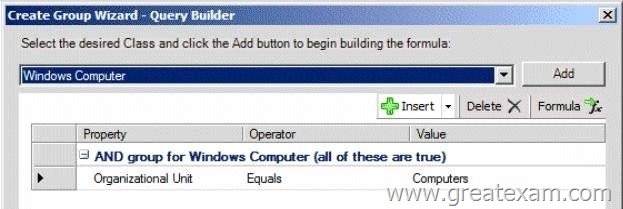
You create a rule named OMRule1 that generates an alert when an error is added to the Application log.
You target OMRule1 to GP1.
You discover that alerts fail to be generated when errors are added to the Application log on Operations1.
You need to ensure that an alert is generated when an error is added to the Application log on Operations1.
What should you modify?
A. the target of OMRulel1
B. the dynamic membership of GP1
C. the category of OMRule1
D. the explicit membership of GP1
Answer: B
Explanation:
How does a rule get to an agent?
For any particular rule/monitor, OpsMgr will enumerate all instances of the target class and apply the rule to each. If there are no instances of the target class on a particular agent, then the rule will do nothing. It’s that simple.
If I can’t target groups, why are they listed when I select a target for a rule?
Groups are classes just like any other. They’re singleton classes where the class and the instance are one and the same, but they are classes nonetheless which is why they show up in the list with all other classes. There are really very few circumstances where you will target a rule at a group though.
What if I do target a group?
You can apply a rule/monitor directly to a group, but it will execute against the group object itself. OpsMgr will not enumerate members of the group and apply the rule to each. Any rules targeted at groups will actually operate on the Root Management Server since groups have no host and unhosted objects are managed by the RMS.
How do I target some group of objects then?
To the specific question of how to get a particular rule/monitor to a subset of components, you have two basic options. Let’s say for example, you have a particular subset of web sites that you need a particular rule to apply.
You could target that rule at the IIS 2003 Web Site class for example, but that would apply the rule to all instances of that class. It would probably apply to sites that you didn’t want.
Option 1 would be to create a new class and target the rule at the class. In the case of an IIS site, this would mean that you would need to go to the Authoring Console or raw XML and create a new class and discovery.
That’s a more advanced solution that most customers will do and probably overkill anyway. Option 2 is the create a rule target at the whole class and disable it. Create a group with the sites you want and create an override for that group to enable your rule. This might sound like a workaround, but it’s a completely valid solution.
How do I know if I’m selecting the right target?
The easiest method to validate you are using a target that actually has instances is to use the Discovered Inventory view in the Operations Console prior to creating your rule/monitor. In the Actions pane is an option called “Change target type…” that will bring up the same Select a Target Type dialog box that you see when you select the target for a rule/monitor. This view will list all instances of the target class you select.
You can validate which agents have an instance of that class and how many instances each has. If there are no instances listed, then the rule isn’t going to do anything. If there are instances, then you not only be confident that the rule/monitor will execute on the agent, but you can also view the properties of the instance that will be accessible to any rules/monitors targeted at it.
http://blogs.technet.com/b/brianwren/archive/2007/08/22/targeting-rules-and-monitors.aspx NOTE: The text below was copied from a duplicate question
https://social.technet.microsoft.com/wiki/contents/articles/7205.operations-manager-dynamicgroup-examples.aspx
Operations Manager Dynamic Group Examples
In Operations Manager, groups are logical collections of objects, such as Windows-based computers, hard disks, or instances of Microsoft SQL Server.
Groups are populated by explicitly adding objects to the group or dynamically according to criteria you set.
For more information on the use of groups, see Creating and Managing Groups in the Operations Guide. This article provides example of group definitions.
The examples describe the items to select in the Query Builder and the resulting formula.
QUESTION 70
Drag and Drop Questions
Your company has a private cloud that is managed by using a System Center 2012 infrastructure. The private cloud contains 200 servers that run Windows Server 2008 R2.
All of the servers are managed by Operations Manager.
The private cloud contains an application named App1 that is deployed on-demand to several servers. The servers that run the application are identified by a registry value set during the application’s installation.
You create a monitor that targets all of the servers.
You need to modify the monitor to only affect the servers that have the application installed. Which three actions should you perform in sequence? (To answer, move the appropriate actions from the list of actions to the answer area and arrange them in the correct order.)
Answer: 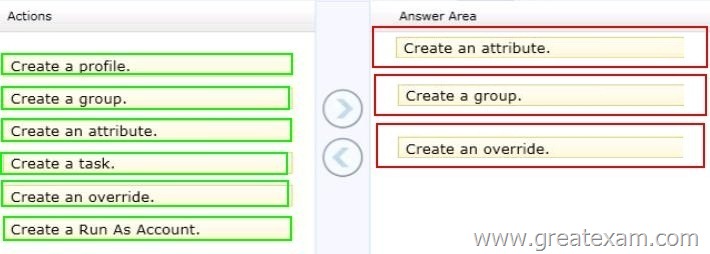
Explanation:
In Operations Manager 2007, you can create attributes to define a commonality within a group of objects that you want to monitor. After you create an attribute, you can create a group whose members are only objects that have the commonality described in your attribute. For example, if you want to monitor a set of servers that all have a common registry value, you create an attribute based on that registry value. To find the servers that have that registry value, you create a group that has a dynamic inclusion rule for only those servers that have the newly created attribute and target the group only to the server object type. Operations Manager then checks the registry of each server to see whether that registry value exists. If it does, that server is added as a member of the group.
When you create an attribute, you must select an object type as a target for it.
Operations Manager adds the new attribute to the existing list of attributes for that object type.
If the target you select is from a sealed management pack, the object type also is sealed and the new attribute cannot be added. Instead, Operations Manager creates a new object type to which it adds the new attribute. By default, this new object type is named after the original object type with _Extended appended to the original name. This new object type contains all the attributes of the original object type, in addition to the attribute you are creating.
You can view existing attributes in the Monitoring area of the Operations console.
If the attributes are defined within a sealed management pack, you can view the properties of the attribute but you cannot change them.
The properties of an attribute include information about where the attribute information is stored, such as the registry or through WMI.
You can create a new attribute for any monitored object, and you can change most of the properties of an attribute that you create.
However, the Attribute Type property, which identifies the source of the attribute information such as the registry, cannot be changed after an attribute is created.
http://systemscenter.ru/opsmgr2007.en/html/26d205e5-a26b-416e-93ae-9f33fe156311.htm
If you want to get more 70-246 exam preparation material, you can download the free 70-246 braindumps in PDF files on GreatExam. It would be great helpful for your exam. All the 70-246 dumps are updated and cover every aspect of the examination. Welcome to choose.